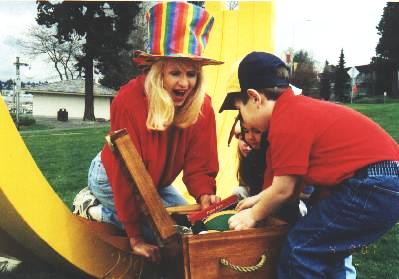My
neighborís daughter came home from school, shoulders bent, face down,
tears running down her cheeks. "Mom they made fun of me again."
I have known this lovely girl for so long, but lately I have noticed that
she has lost that pep in her step and the sparkle in her eyes. What
happened? Where is it?
Her little
brother reacts in exactly the opposite way to humiliation. He gets angry and
aggressive, and his behavior is hard to deal with. Though we have two
children reacting differently to the same situation, both have lost their
confidence and strength.
Are our
children ready to face this fast-paced and ever-changing world? Technological
progress is great and breathtaking, but Have we given the same attention and
dedication to childrenís emotional intelligence that we have to making them
computer literate? Have we given our children enough tools to be brave and
persevere in the face of adversity or challenge?
THE
BULLIES
First it is
important to understand where bullies come from. Bullies are children who deep,
deep inside feel lost and very fearful. They donít want to experience that
painful feeling again. In an attempt to regain their position, they make fun of
others or they command others to do their bidding. Bullies intimidate others in
the hope that they gain respect and recognition. However, they create just
the opposite situation. Unfortunately, these bullies havenít learned how to
deal with their emotions and feelings in a constructive way Ė they are out of
control when it comes to dealing with their emotions. As a result of being out
of control when it comes to dealing with their emotions, they contribute to the
creation of new bullies. Sadly enough, this causes the chain of intimidation to
continue.
Emotions
are natural and need to be felt and expressed (e-motion = energy in motion). If
not expressed, not understood and tucked away over and over again, emotions get
distorted and we start to overreact. If tucked away long enough, emotions may
boomerang, leaving others behind with puzzled faces looking for answers to such
behavior when there are seemingly are none.
CREATING A
SURVIVAL KIT
I am fortunate to
have worked with mentally and physically challenged children in Europe for more
than 10 years. I say fortunate because these children taught me much about inner
strength and the human spirit. The children were bullied, because they looked
and acted different from their peers. They wanted to live and have fun
despite their circumstances. They reminded me of the importance of the
joy of life.
They inspired me to come up with answers to make them ready for the world.
During the
time I worked with them, I developed a program to teach them to recognize
and focus on their strengths and how to deal with their feelings. I created a
"survival kit", that taught them how to access their happiness and
what to do when they "lose" it. The program included a treasure chest
filled with tools they could use to improve the way they felt. They learned to
see the best in each other and to disregard the rest.
My program
has emerged into several books and a special program for young children, called
the Woolly Wizard.
The Woolly Wizard program utilizes stuffed animals and role play, to teach
children about different emotions and to demonstrate how they look and feel. The
children then have access to these tools whenever they need them.
The
program teaches children they are in charge of their own behavior and feelings.
Best of all, it teaches them that they
can change how they feel and act. Having
a choice, children learn to be responsible for what they create. They
learn , how to "flip the switch"- and use their rainbow socks to feel
better. Parents and teachers also learn concepts to reinforce the lessons
and enhance the effectiveness of the program
The
program also helps children funnel their creative urges. Imagination is a
natural phenomenon we all have. We cannot stop our childrenís creative urge;
creativity and emotion need to be expressed. And if children cannot
express emotions in a positive, energetic way, they will create in a negative
way. Whining, critical children are often bored, not satisfying their creative
needs Their sparkle is gone as they have lost focus on their strengths and
capabilities.
The Wooly
Wizard program demonstrates to children, and reinforces to parents, the need for
clear limits and consequences for actions. For children to feel freedom,
they need to know their boundaries. Children need to hear, "I
believe in you," over and over again, but they also need to hear, "No, this is not okay; you cannot do that!" We need to be
able to say to our children: "I love you, but I donít like your behavior
right now"
When
children are taught these basics at an early age in an uplifting way, they are
far ahead of the game and they will always remember them, no matter what.
Without those basics, they may no longer be certain of who they are or where
they are going. Children are wizards, we just need to remind them how to regain
their self-confidence or reclaim their happiness when they feel lost.
RAISE A
WOOLLY WIZARD
We may not always
be able or have the time to help or protect our children. Therefore, they need
to have their own tools, know how to access them and know how to use them in an
empowering way. We can teach children that
they have a choice to be a bully wizard or a Woolly Wizard.

